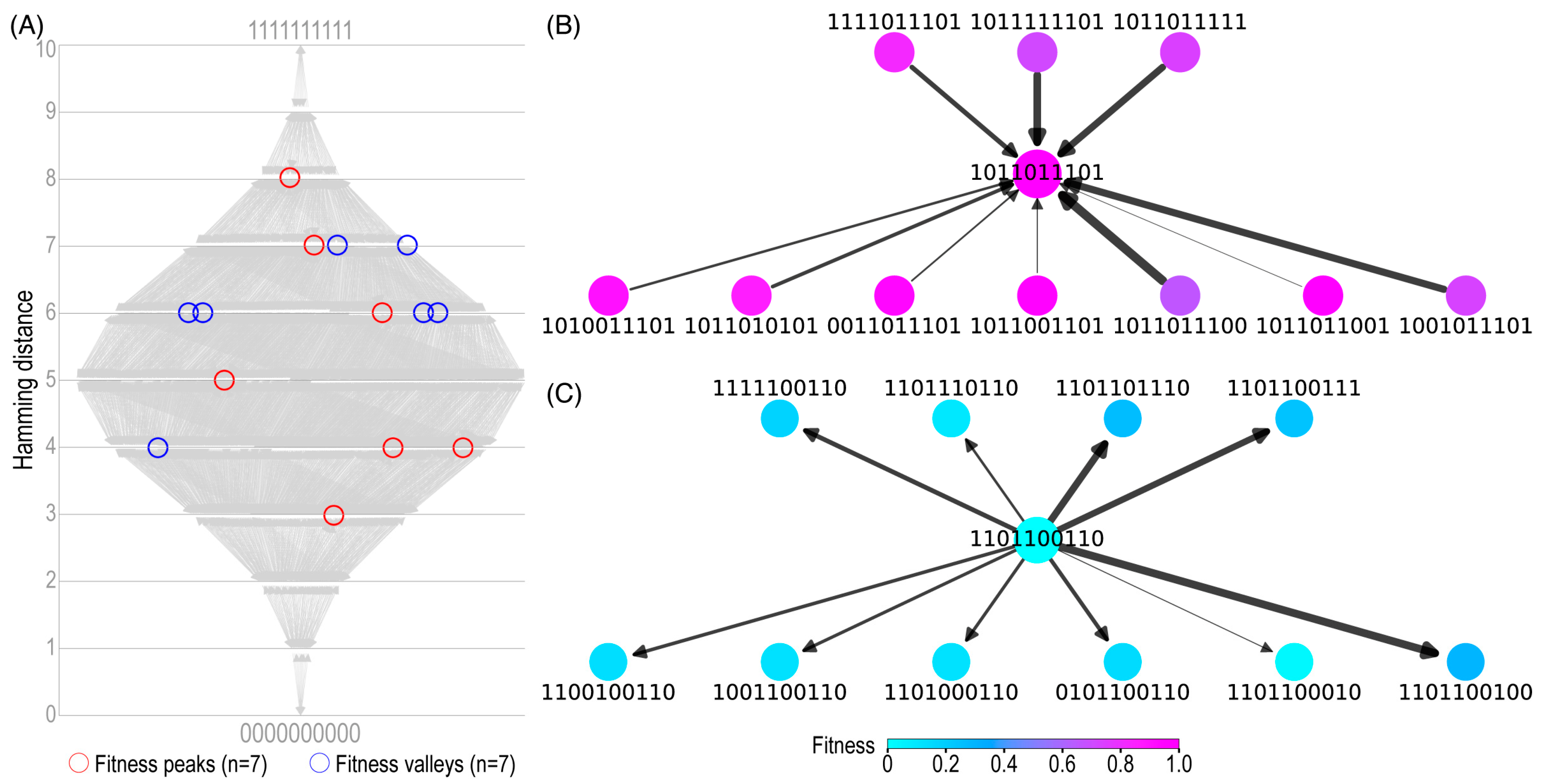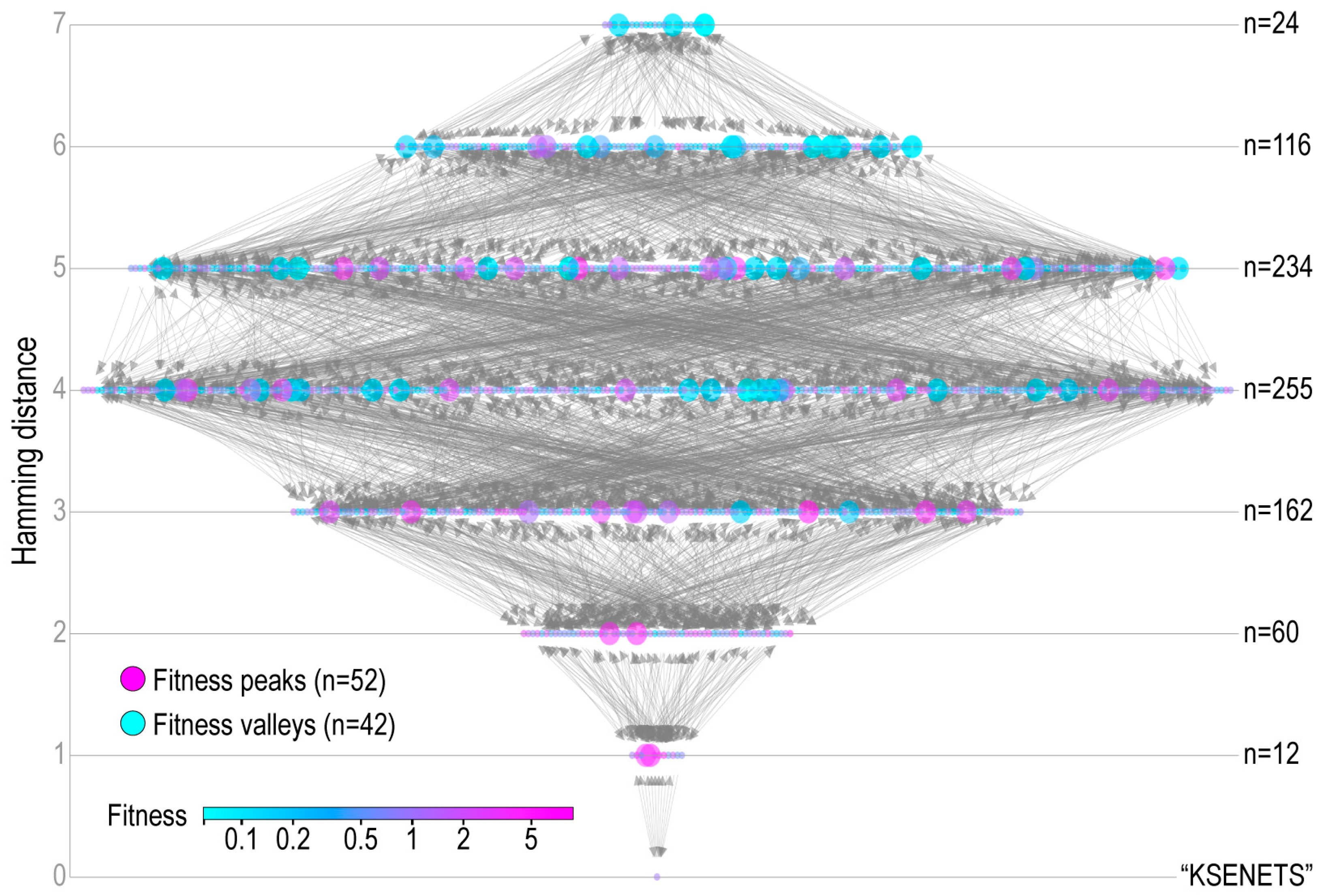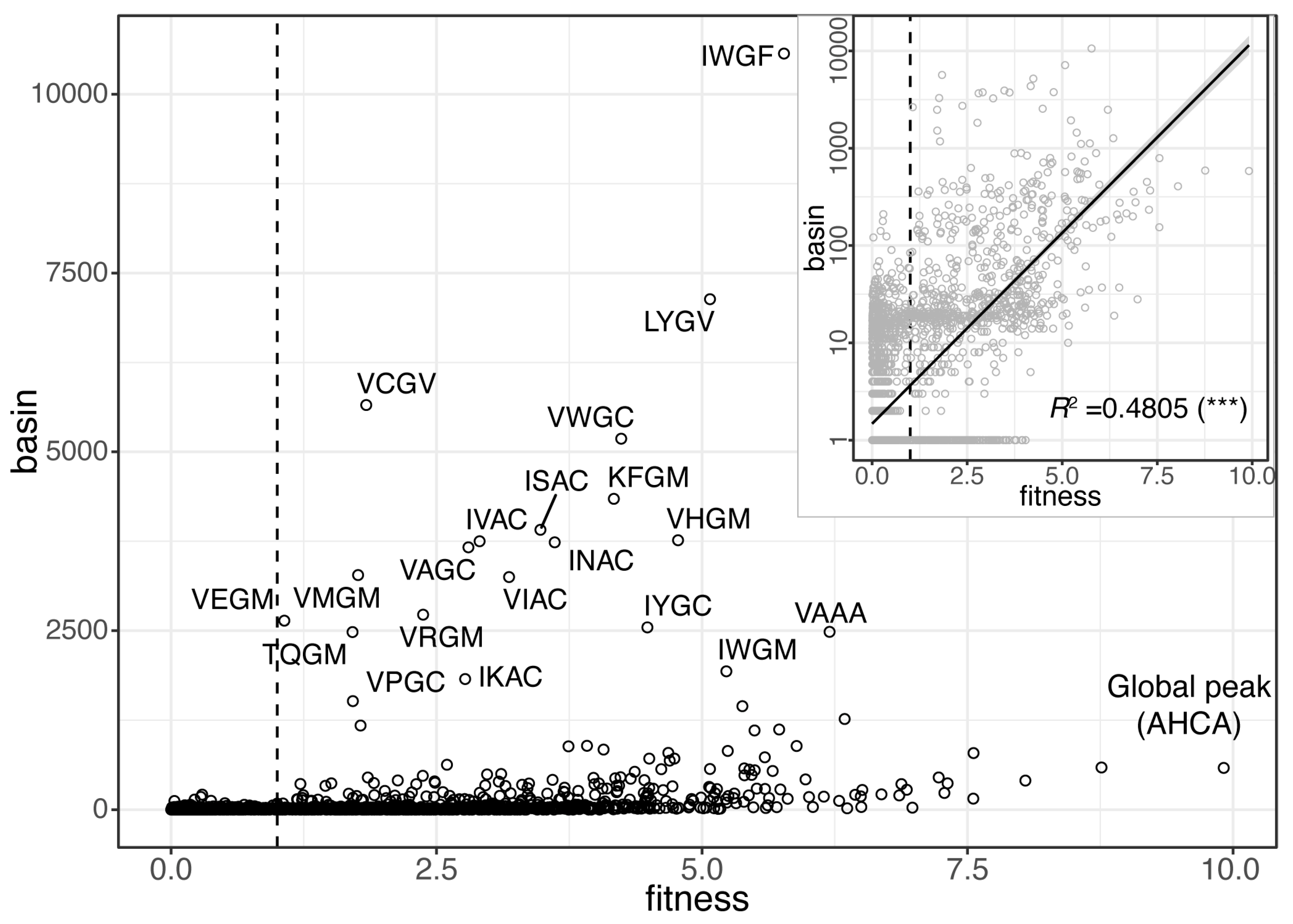Novelty Search Promotes Antigenic Diversity in Microbial Pathogens
Abstract
:1. Introduction
1.1. Antigenic Diversification
1.2. Fitness Landscapes
1.3. Evolutionary Algorithms
2. Algorithms and Methods
2.1. Simulated Fitness Landscapes Based on NK Model
2.2. Empirical Landscapes
2.2.1. GB1 4-Epitope Site Landscape
2.2.2. NA 7-Variable SITE Landscape
2.3. Characterization of Fitness Landscapes
2.4. Evolutionary Walks
2.4.1. Fitness-Seeking Walks
2.4.2. Novelty-Seeking Walks
2.4.3. Fitness–Novelty Hybrid Walks
2.5. Landscape Visualization and Data Analysis
3. Results
3.1. Simulated Landscapes
3.2. Performances on Simulated Landscapes
3.3. Empirical Landscapes and Performance Measures
3.3.1. Streptococcal GB1
3.3.2. Human Influenza NA
4. Discussion
4.1. Evolutionary and Non-Evolutionary Walks
4.2. Biological Factors Facilitating Evolution of Novel Antigens
4.3. Variant Predictability and Design of Broadly Protective Vaccines
5. Conclusions
Author Contributions
Funding
Institutional Review Board Statement
Informed Consent Statement
Data Availability Statement
Acknowledgments
Conflicts of Interest
References
- Burton, D.R.; Topol, E.J. Variant-proof vaccines—Invest now for the next pandemic. Nature 2021, 590, 386–388. [Google Scholar] [CrossRef] [PubMed]
- Dolgin, E. Pan-coronavirus vaccine pipeline takes form. Nat. Rev. Drug Discov. 2022, 21, 324–326. [Google Scholar] [CrossRef] [PubMed]
- Houser, K.; Subbarao, K. Influenza Vaccines: Challenges and Solutions. Cell Host Microbe 2015, 17, 295–300. [Google Scholar] [CrossRef] [PubMed] [Green Version]
- Gupta, S.; Maiden, M.; Feavers, I.M.; Nee, S.; May, R.M.; Anderson, R. The maintenance of strain structure in populations of recombining infectious agents. Nat. Med. 1996, 2, 437–442. [Google Scholar] [CrossRef]
- Palmer, G.H.; Bankhead, T.; Seifert, H.S. Antigenic Variation in Bacterial Pathogens. Microbiol. Spectr. 2016, 4, 445–480. [Google Scholar] [CrossRef] [Green Version]
- Papkou, A.; Guzella, T.; Yang, W.; Koepper, S.; Pees, B.; Schalkowski, R.; Barg, M.-C.; Rosenstiel, P.C.; Teotónio, H.; Schulenburg, H. The genomic basis of Red Queen dynamics during rapid reciprocal host–pathogen coevolution. Proc. Natl. Acad. Sci. USA 2018, 116, 923–928. [Google Scholar] [CrossRef] [Green Version]
- Georgieva, M.; Buckee, C.O.; Lipsitch, M. Models of immune selection for multi-locus antigenic diversity of pathogens. Nat. Rev. Immunol. 2018, 19, 55–62. [Google Scholar] [CrossRef]
- Haven, J.; Vargas, L.C.; Mongodin, E.F.; Xue, V.; Hernandez, Y.; Pagan, P.; Fraser-Liggett, C.M.; Schutzer, S.E.; Luft, B.J.; Casjens, S.R.; et al. Pervasive Recombination and Sympatric Genome Diversification Driven by Frequency-Dependent Selection in Borrelia burgdorferi, the Lyme Disease Bacterium. Genetics 2011, 189, 951–966. [Google Scholar] [CrossRef] [Green Version]
- Gomes, M.G.M.; Medley, G.F.; Nokes, D.J. On the determinants of population structure in antigenically diverse pathogens. Proc. R. Soc. B Boil. Sci. 2002, 269, 227–233. [Google Scholar] [CrossRef] [Green Version]
- Wright, S. The Roles of Mutation, Inbreeding, Crossbreeding and Selection in Evolution. In Proceedings of the Sixth International Congress of Genetics, Ithaca, NY, USA, 24–31 August 1932; Volume 1, pp. 356–366. [Google Scholar]
- de Visser, J.A.G.; Krug, J. Empirical fitness landscapes and the predictability of evolution. Nat. Rev. Genet. 2014, 15, 480–490. [Google Scholar] [CrossRef]
- Kauffman, S.A.; Weinberger, E.D. The NK model of rugged fitness landscapes and its application to maturation of the immune response. J. Theor. Biol. 1989, 141, 211–245. [Google Scholar] [CrossRef]
- Hordijk, W.; Kauffman, S.A.; Stadler, P.F. Average Fitness Differences on NK Landscapes. Theory Biosci. 2019, 139, 1–7. [Google Scholar] [CrossRef]
- Kaznatcheev, A. Computational Complexity as an Ultimate Constraint on Evolution. Genetics 2019, 212, 245–265. [Google Scholar] [CrossRef] [Green Version]
- Ashworth, J.; Lee, Y.; Shen, J.; Kim, E.; Decker, Z.; Yoder, J. Evolution of Developmental Strategies in NK Fitness Landscapes. In Proceedings of the ALIFE 2022: The 2022 Conference on Artificial Life, Trento, Italy, 18–22 July 2022. [Google Scholar] [CrossRef]
- Franke, J.; Klözer, A.; De Visser, J.A.G.M.; Krug, J. Evolutionary Accessibility of Mutational Pathways. PLoS Comput. Biol. 2011, 7, e1002134. [Google Scholar] [CrossRef] [Green Version]
- Nowak, S.; Krug, J. Analysis of adaptive walks on NK fitness landscapes with different interaction schemes. J. Stat. Mech. Theory Exp. 2015, 2015, P06014. [Google Scholar] [CrossRef] [Green Version]
- Schmiegelt, B.; Krug, J. Evolutionary Accessibility of Modular Fitness Landscapes. J. Stat. Phys. 2013, 154, 334–355. [Google Scholar] [CrossRef] [Green Version]
- Fowler, D.M.; Fields, S. Deep mutational scanning: A new style of protein science. Nat. Methods 2014, 11, 801–807. [Google Scholar] [CrossRef]
- Yi, X.; Dean, A.M. Adaptive Landscapes in the Age of Synthetic Biology. Mol. Biol. Evol. 2019, 36, 890–907. [Google Scholar] [CrossRef] [Green Version]
- Haddox, H.K.; Dingens, A.S.; Bloom, J.D. Experimental Estimation of the Effects of All Amino-Acid Mutations to HIV’s Envelope Protein on Viral Replication in Cell Culture. PLoS Pathog. 2016, 12, e1006114. [Google Scholar] [CrossRef] [Green Version]
- Starr, T.N.; Greaney, A.J.; Hannon, W.W.; Loes, A.N.; Hauser, K.; Dillen, J.R.; Ferri, E.; Farrell, A.G.; Dadonaite, B.; McCallum, M.; et al. Shifting mutational constraints in the SARS-CoV-2 receptor-binding domain during viral evolution. Science 2022, 377, 420–424. [Google Scholar] [CrossRef]
- Wang, Y.; Lei, R.; Nourmohammad, A.; Wu, N.C. Antigenic evolution of human influenza H3N2 neuraminidase is constrained by charge balancing. Elife 2021, 10, e72516. [Google Scholar] [CrossRef] [PubMed]
- Wu, N.C.; Dai, L.; Olson, C.A.; Lloyd-Smith, J.O.; Sun, R. Adaptation in protein fitness landscapes is facilitated by indirect paths. Elife 2016, 5, e16965. [Google Scholar] [CrossRef] [PubMed]
- Kistemaker, S.; Whiteson, S. Critical Factors in the Performance of Novelty Search. In Proceedings of the 13th Annual Conference on Genetic and Evolutionary Computation, Dublin, Ireland, 12–16 July 2011; Association for Computing Machinery: New York, NY, USA, 2011; pp. 965–972. [Google Scholar]
- Lehman, J.; Stanley, K.O. Abandoning Objectives: Evolution Through the Search for Novelty Alone. Evol. Comput. 2011, 19, 189–223. [Google Scholar] [CrossRef] [PubMed] [Green Version]
- Lehman, J.; Stanley, K.O. Efficiently Evolving Programs through the Search for Novelty. In Proceedings of the 12th Annual Conference on Genetic and Evolutionary Computation, Portland, OR, USA, 7–11 July 2010; Association for Computing Machinery: New York, NY, USA, 2010; pp. 837–844. [Google Scholar]
- Novak, J.; Richmond-Crosset, K. Evolutionary Algorithms Using Combined Objective and Novelty Search in Unconstrained Space. 2017. Available online: https://www.cs.swarthmore.edu/~meeden/cs81/f17/projects/JeffKyle.pdf (accessed on 1 June 2022).
- Song, S.; Zhang, J. Unbiased inference of the fitness landscape ruggedness from imprecise fitness estimates. Evolution 2021, 75, 2658–2671. [Google Scholar] [CrossRef] [PubMed]
- Hwang, S.; Schmiegelt, B.; Ferretti, L.; Krug, J. Universality Classes of Interaction Structures for NK Fitness Landscapes. J. Stat. Phys. 2018, 172, 226–278. [Google Scholar] [CrossRef] [Green Version]
- Tomassini, M. A Local Optima Network View of Real Function Fitness Landscapes. Entropy 2022, 24, 703. [Google Scholar] [CrossRef]
- Barlukova, A.; Rouzine, I.M. The evolutionary origin of the universal distribution of mutation fitness effect. PLoS Comput. Biol. 2021, 17, e1008822. [Google Scholar] [CrossRef]
- Hagberg, A.A.; Schult, D.A.; Swart, P.J. Exploring Network Structure, Dynamics, and Function Using NetworkX. In Proceedings of the 7th Python in Science Conference, Pasadena, CA, USA, 19–24 August 2008; Varoquaux, G., Vaught, T., Millman, J., Eds.; U.S. Department of Energy, Office of Scientific and Technical Information: Pasadena, CA, USA, 2008; pp. 11–15. [Google Scholar]
- Vérel, S.; Daolio, F.; Ochoa, G.; Tomassini, M. Local Optima Networks with Escape Edges. In Proceedings of the Artificial Evolution, Chengdu, China, 26–28 October 2012; Hao, J.-K., Legrand, P., Collet, P., Monmarché, N., Lutton, E., Schoenauer, M., Eds.; Springer: Berlin/Heidelberg, Germany, 2012; pp. 49–60. [Google Scholar]
- Lehman, J.; Clune, J.; Misevic, D.; Adami, C.; Altenberg, L.; Beaulieu, J.; Bentley, P.; Bernard, S.; Beslon, G.; Bryson, D.M.; et al. The Surprising Creativity of Digital Evolution: A Collection of Anecdotes from the Evolutionary Computation and Artificial Life Research Communities. Artif. Life 2020, 26, 274–306. [Google Scholar] [CrossRef] [Green Version]
- Soros, K.O.S.; Joel Lehman, L. Open-Endedness: The Last Grand Challenge You’ve Never Heard of. Available online: https://www.oreilly.com/radar/open-endedness-the-last-grand-challenge-youve-never-heard-of/ (accessed on 5 November 2022).
- Grantham, R. Amino Acid Difference Formula to Help Explain Protein Evolution. Science 1974, 185, 862–864. [Google Scholar] [CrossRef]
- Kyte, J.; Doolittle, R.F. A simple method for displaying the hydropathic character of a protein. J. Mol. Biol. 1982, 157, 105–132. [Google Scholar] [CrossRef] [Green Version]
- Zimmerman, J.; Eliezer, N.; Simha, R. The characterization of amino acid sequences in proteins by statistical methods. J. Theor. Biol. 1968, 21, 170–201. [Google Scholar] [CrossRef]
- Kawashima, S.; Pokarowski, P.; Pokarowska, M.; Kolinski, A.; Katayama, T.; Kanehisa, M. AAindex: Amino acid index database, progress report 2008. Nucleic Acids Res. 2007, 36, D202–D205. [Google Scholar] [CrossRef] [Green Version]
- Srivastava, M.; Payne, J.L. On the incongruence of genotype-phenotype and fitness landscapes. PLoS Comput. Biol. 2022, 18, e1010524. [Google Scholar] [CrossRef]
- Lobkovsky, A.E.; Wolf, Y.I.; Koonin, E.V. Predictability of Evolutionary Trajectories in Fitness Landscapes. PLoS Comput. Biol. 2011, 7, e1002302. [Google Scholar] [CrossRef] [Green Version]
- Mitchell, M. An Introduction to Genetic Algorithms; MIT Press: Cambridge, MA, USA, 1998; ISBN 978-0-262-63185-3. [Google Scholar]
- Didelot, X.; Maiden, M.C. Impact of recombination on bacterial evolution. Trends Microbiol. 2010, 18, 315–322. [Google Scholar] [CrossRef] [Green Version]
- Fraser, C.; Hanage, W.P.; Spratt, B.G. Recombination and the Nature of Bacterial Speciation. Science 2007, 315, 476–480. [Google Scholar] [CrossRef] [Green Version]
- Smith, J.M.; Smith, N.H.; O’Rourke, M.; Spratt, B.G. How Clonal Are Bacteria? Proc. Natl. Acad. Sci. USA 1993, 90, 4384–4388. [Google Scholar] [CrossRef] [Green Version]
- Norris, S.J. vls Antigenic Variation Systems of Lyme Disease Borrelia: Eluding Host Immunity through both Random, Segmental Gene Conversion and Framework Heterogeneity. Microbiol. Spectr. 2014, 2, 471–489. [Google Scholar] [CrossRef] [PubMed] [Green Version]
- Taylor, J.; Rudenko, G. Switching trypanosome coats: What’s in the wardrobe? Trends Genet. 2006, 22, 614–620. [Google Scholar] [CrossRef]
- Cvijović, I.; Ba, A.N.N.; Desai, M.M. Experimental Studies of Evolutionary Dynamics in Microbes. Trends Genet. 2018, 34, 693–703. [Google Scholar] [CrossRef]
- Lenski, R.E. Experimental evolution and the dynamics of adaptation and genome evolution in microbial populations. ISME J. 2017, 11, 2181–2194. [Google Scholar] [CrossRef] [PubMed] [Green Version]
- Wang, I.-N.; Dykhuizen, D.E.; Qiu, W.; Dunn, J.J.; Bosler, E.M.; Luft, B.J. Genetic Diversity of ospC in a Local Population of Borrelia burgdorferi sensu stricto. Genetics 1999, 151, 15–30. [Google Scholar] [CrossRef] [PubMed]
- Graves, C.J.; Ros, V.I.D.; Stevenson, B.; Sniegowski, P.D.; Brisson, D. Natural Selection Promotes Antigenic Evolvability. PLoS Pathog. 2013, 9, e1003766. [Google Scholar] [CrossRef] [PubMed] [Green Version]
- Li, L.; Di, L.; Akther, S.; Zeglis, B.M.; Qiu, W. Development of Recombinant Monoclonal Antibodies Targeting Conserved VlsE Epitopes in Lyme Disease Pathogens. Microbiol Spectr. 2022, 10, e0174322. [Google Scholar] [CrossRef] [PubMed]
- Xie, X.; Qiu, W.-G.; Lipke, P.N. Accelerated and Adaptive Evolution of Yeast Sexual Adhesins. Mol. Biol. Evol. 2011, 28, 3127–3137. [Google Scholar] [CrossRef] [Green Version]
- Galloway, S.E.; Paul, P.; MacCannell, D.R.; Johansson, M.A.; Brooks, J.T.; MacNeil, A.; Slayton, R.B.; Tong, S.; Silk, B.J.; Armstrong, G.L.; et al. Emergence of SARS-CoV-2 B.1.1.7 Lineage—United States, December 29, 2020–January 12, 2021. MMWR Morb. Mortal. Wkly. Rep. 2021, 70, 95–99. [Google Scholar] [CrossRef]
- Simoncini, D.; Barbe, S.; Schiex, T.; Verel, S. Fitness Landscape Analysis around the Optimum in Computational Protein Design. In Proceedings of the Genetic and Evolutionary Computation Conference, Kyoto, Japan, 15–19 July 2018; Association for Computing Machinery: New York, NY, USA, 2018; pp. 355–362. [Google Scholar]
- Di, L.; Akther, S.; Bezrucenkovas, E.; Ivanova, L.; Sulkow, B.; Wu, B.; Mneimneh, S.; Gomes-Solecki, M.; Qiu, W.-G. Maximum antigen diversification in a lyme bacterial population and evolutionary strategies to overcome pathogen diversity. ISME J. 2021, 16, 447–464. [Google Scholar] [CrossRef]
- Crevar, C.J.; Carter, D.M.; Lee, K.Y.J.; Ross, T.M. Cocktail of H5N1 COBRA HA vaccines elicit protective antibodies against H5N1 viruses from multiple clades. Hum. Vaccines Immunother. 2015, 11, 572–583. [Google Scholar] [CrossRef] [Green Version]
- Rolland, M.; Jensen, M.A.; Nickle, D.C.; Yan, J.; Learn, G.H.; Heath, L.; Weiner, D.; Mullins, J.I. Reconstruction and Function of Ancestral Center-of-Tree Human Immunodeficiency Virus Type 1 Proteins. J. Virol. 2007, 81, 8507–8514. [Google Scholar] [CrossRef] [Green Version]
- Gaschen, B.; Taylor, J.; Yusim, K.; Foley, B.; Gao, F.; Lang, D.; Novitsky, V.; Haynes, B.; Hahn, B.H.; Bhattacharya, T.; et al. Diversity Considerations in HIV-1 Vaccine Selection. Science 2002, 296, 2354–2360. [Google Scholar] [CrossRef]








| Landscape | Hap Length | #Haps a | #Peaks (Peak/Hap Ratio b) | Fitness Distribution c {min, max} | Ruggedness (r/s Ratio d) | Basin of Attraction (b) e |
|---|---|---|---|---|---|---|
| NK (K = 0) | 10 | 1024 | 1 (1:1024) | N{0, 1} | 3 × 10−6 | 100% |
| NK (K = 1) | 10 | 1024 | 4 (1:256) | N{0, 1} | 2.63 | 35.1% |
| NK (K = 2) | 10 | 1024 | 7 (1:146) | N{0, 1} | 1.79 | 26.4% |
| NK (K = 3) | 10 | 1024 | 15 (1:68) | N{0, 1} | 4.79 | 12.4% |
| NK (K = 4) | 10 | 1024 | 22 (1:47) | N{0, 1} | 4.24 | 12.4% |
| NK (K = 5) | 10 | 1024 | 28 (1:37) | N{0, 1} | 6.10 | 10.4% |
| NK (K = 6) | 10 | 1024 | 48 (1:21) | N{0, 1} | 8.19 | 8.11% |
| NK (K = 7) | 10 | 1024 | 59 (1:17) | N{0, 1} | 10.3 | 6.45% |
| NK (K = 8) | 10 | 1024 | 73 (1:14) | N{0, 1} | 15.2 | 1.95% |
| NK (K = 9) | 10 | 1024 | 101 (1:10) | N{0, 1} | 22.2 | 1.37% |
| GB1 | 4 | 160,000 | 6409 (1:25) | E{0, 9.91} | n.a. | 0.36% |
| NA | 7 | 864 | 40 (1:22) | E{0.06, 8.81} | n.a. | 0.46% |
Disclaimer/Publisher’s Note: The statements, opinions and data contained in all publications are solely those of the individual author(s) and contributor(s) and not of MDPI and/or the editor(s). MDPI and/or the editor(s) disclaim responsibility for any injury to people or property resulting from any ideas, methods, instructions or products referred to in the content. |
© 2023 by the authors. Licensee MDPI, Basel, Switzerland. This article is an open access article distributed under the terms and conditions of the Creative Commons Attribution (CC BY) license (https://creativecommons.org/licenses/by/4.0/).
Share and Cite
Ely, B.; Koh, W.; Ho, E.; Hassan, T.M.; Pham, A.V.; Qiu, W. Novelty Search Promotes Antigenic Diversity in Microbial Pathogens. Pathogens 2023, 12, 388. https://doi.org/10.3390/pathogens12030388
Ely B, Koh W, Ho E, Hassan TM, Pham AV, Qiu W. Novelty Search Promotes Antigenic Diversity in Microbial Pathogens. Pathogens. 2023; 12(3):388. https://doi.org/10.3390/pathogens12030388
Chicago/Turabian StyleEly, Brandon, Winston Koh, Eamen Ho, Tasmina M. Hassan, Anh V. Pham, and Weigang Qiu. 2023. "Novelty Search Promotes Antigenic Diversity in Microbial Pathogens" Pathogens 12, no. 3: 388. https://doi.org/10.3390/pathogens12030388
APA StyleEly, B., Koh, W., Ho, E., Hassan, T. M., Pham, A. V., & Qiu, W. (2023). Novelty Search Promotes Antigenic Diversity in Microbial Pathogens. Pathogens, 12(3), 388. https://doi.org/10.3390/pathogens12030388






